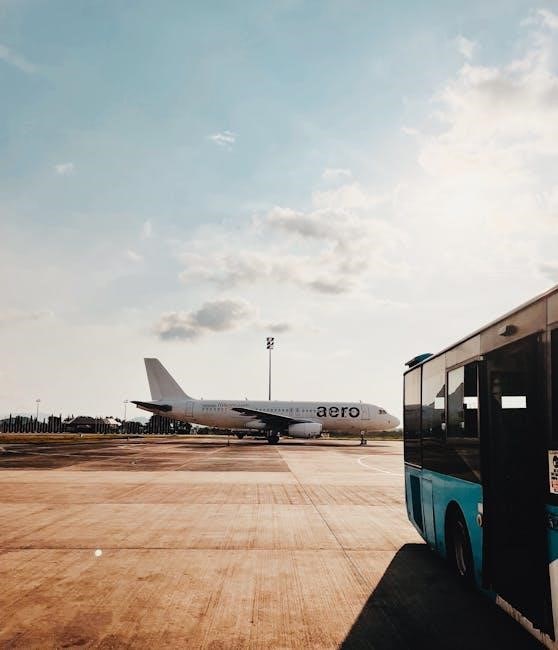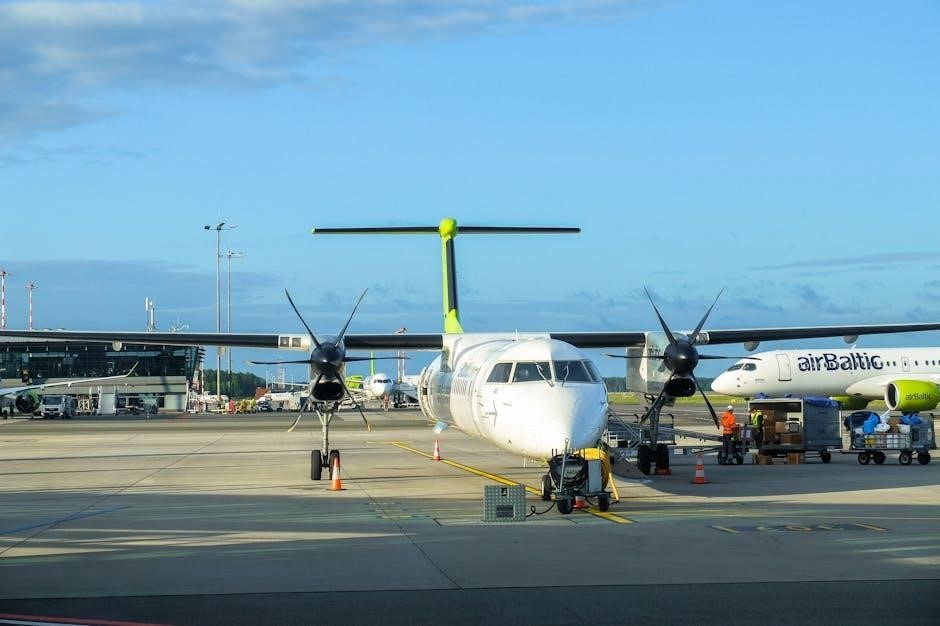Air traffic control ensures the safe and efficient movement of aircraft. Controllers guide planes through takeoff, flight, and landing, managing traffic flow and using advanced technology.
What Is an Air Traffic Controller?
An air traffic controller is a trained professional responsible for guiding aircraft safely through takeoff, landing, and flight. They coordinate movements, issue clearances, and ensure safe distances between planes. Using radar systems and communication tools, controllers manage traffic flow, prevent collisions, and adapt to changing conditions. Their role is critical for aviation safety, requiring sharp focus and quick decision-making. Controllers work in towers or control centers, directing pilots to maintain orderly and efficient airspace operations globally.
The Importance of Air Traffic Controllers in Aviation
Air traffic controllers play a crucial role in ensuring the safety and efficiency of air travel. They manage the flow of aircraft, preventing collisions and maintaining orderly operations. By issuing clearances, coordinating takeoffs, and monitoring flight paths, controllers safeguard the lives of passengers and crew. Their expertise is essential for handling emergencies, reducing delays, and optimizing airspace usage. Without their oversight, modern aviation would face significant challenges in maintaining safety and operational efficiency at busy airports and in crowded skies.

Qualifications and Steps to Become an Air Traffic Controller
Becoming an air traffic controller requires meeting specific qualifications and following a structured process. Candidates must pass rigorous physical exams, complete FAA Academy training, and meet age requirements.
Education and Physical Requirements
To become an air traffic controller, candidates typically need a bachelor’s degree or equivalent experience. Physical requirements include passing rigorous medical exams, vision tests, and hearing assessments. Controllers must maintain focus and stamina due to the demanding nature of the job. Age restrictions may apply, and candidates must demonstrate mental and physical fitness to handle high-stress environments. These standards ensure controllers can perform effectively in critical situations, maintaining safety and efficiency in air traffic management.
The Application and Selection Process
The application process for air traffic controllers typically involves submitting an application through official channels, such as government or aviation authority websites. Candidates must pass initial assessments, including aptitude tests and medical evaluations. A background check and physical exam are also required. Selected applicants undergo rigorous interviews and psychological evaluations to assess suitability for the role. The process is highly competitive, with only a small percentage advancing to training programs. Successful candidates are then enrolled in specialized training at the FAA Academy or similar institutions.
Training at the FAA Academy
Training at the FAA Academy is intensive, focusing on air traffic control procedures, radar systems, and communication techniques. Candidates learn to manage high-stress situations, make quick decisions, and coordinate with pilots. The curriculum includes simulated real-world scenarios to prepare trainees for the demands of the job. Completion of the program leads to certification, qualifying graduates to work as air traffic controllers at various facilities, ensuring they are fully prepared to handle the complexities of aviation safely and efficiently.
Key Skills and Traits of Successful Air Traffic Controllers
Successful air traffic controllers possess sharp attention to detail, excellent multitasking abilities, and strong decision-making skills. They must remain calm under pressure and communicate clearly.
Attention to Detail and Multitasking Abilities
Air traffic controllers must maintain sharp focus, monitoring multiple aircraft simultaneously. They track flight paths, altitudes, and speeds, ensuring safety and efficiency. Multitasking is crucial, as controllers juggle communication with pilots, radar systems, and ground teams. Even minor errors can have severe consequences, making attention to detail paramount. Controllers must process information quickly and accurately, adapting to dynamic situations while managing stress effectively. These skills are essential for preventing collisions and maintaining smooth air traffic flow.
Decision-Making and Communication Skills
Air traffic controllers must make quick, precise decisions to ensure safety and efficiency. Effective communication is critical, as clear instructions guide pilots and ground crews. Controllers must remain calm under pressure, issuing clearances and handling emergencies with confidence. Strong decision-making prevents collisions, while concise communication avoids misunderstandings. These skills are vital for managing complex situations and ensuring seamless air traffic flow, even during high-stress scenarios.

Tools and Technologies Used by Air Traffic Controllers
Air traffic controllers rely on radar systems, surveillance technology, and advanced software to monitor and manage aircraft movements. Effective communication tools ensure clear instructions for pilots and ground crews.
Radar Systems and Surveillance Technology
Radar systems and surveillance technology are critical tools for air traffic controllers, providing real-time data on aircraft positions, altitudes, and speeds. These systems enable controllers to track multiple aircraft simultaneously, ensuring safe distances and efficient traffic flow. Advanced surveillance technologies, such as ADS-B (Automatic Dependent Surveillance-Broadcast), enhance accuracy and reliability. Together, radar and surveillance systems form the backbone of modern air traffic control, preventing collisions and optimizing flight paths for seamless operations.
Communication Equipment and Software
Communication equipment and software are essential for air traffic controllers to ensure clear and precise interactions with pilots and other stakeholders. Radios, headsets, and digital communication systems enable real-time voice communication, while software tools manage flight data, integrate radar information, and facilitate decision-making. Advanced systems, such as voice recognition and automated systems, enhance efficiency and reduce errors. These tools are critical for maintaining safe and coordinated air traffic management, enabling controllers to issue clear instructions and respond to dynamic situations effectively.

Career Benefits and Challenges
Air traffic control offers high salaries, job security, and benefits, but demands intense focus, quick decision-making, and handling high-stress situations, impacting work-life balance significantly.
Salary, Job Security, and Benefits
Air traffic controllers receive a highly competitive salary, with medians exceeding $138,556 annually. The role offers exceptional job security due to consistent demand and limited turnover. Benefits include comprehensive health insurance, retirement plans, and paid leave. Controllers also enjoy non-monetary perks, such as the pride of ensuring aviation safety and playing a critical role in global air travel. These factors make the career financially rewarding and personally fulfilling, despite the challenges associated with the job.
High Stress Levels and Work-Life Balance
Air traffic control is a high-stress profession due to the dynamic nature of managing aircraft movements and making critical decisions under pressure. Controllers often work irregular shifts, including nights, weekends, and holidays, which can disrupt personal life. The demanding environment can lead to physical and mental fatigue, requiring strong coping strategies. Despite these challenges, many controllers find fulfillment in their role, relying on teamwork and stress management techniques to maintain balance and resilience in their demanding careers.
Training and Certification Programs
Air traffic controllers undergo rigorous training and certification programs, covering essential topics like radar systems, communication protocols, and emergency procedures to ensure proficiency in managing air traffic safely.
Initial Training and Certification Process
The initial training for air traffic controllers begins with pre-employment screening, followed by intensive courses at the FAA Academy. Candidates learn radar systems, weather interpretation, and emergency protocols. They practice scenario-based simulations to develop decision-making skills. Upon completing theoretical and practical exams, they earn certification and are assigned to a facility. Continuous assessments ensure readiness for real-world challenges, making the process comprehensive and demanding, ensuring only the most qualified individuals succeed in this critical role.
Ongoing Professional Development
Ongoing professional development is crucial for air traffic controllers to stay updated with evolving technologies and procedures. Regular training sessions, workshops, and recurrent assessments ensure proficiency. Controllers participate in scenario-based exercises to enhance decision-making and adapt to new systems. Periodic evaluations and career advancement opportunities further refine their expertise, enabling them to handle complex situations effectively and maintain high standards of safety and efficiency in aviation operations.
Handling Emergencies and Critical Situations
Air traffic controllers must swiftly respond to emergencies, coordinating with pilots and ground crews to ensure safe landings and minimize risks during system failures or critical events.
Protocols for Emergency Landings and System Failures
In emergencies, air traffic controllers prioritize aircraft safety by issuing clearances for immediate landings. They assess situations, clear runways, and coordinate with ground crews. Controllers maintain constant communication with pilots, guiding them through critical maneuvers. System failures trigger backup protocols, ensuring continued safe operations. Rerouting traffic and managing airspace efficiently are key to preventing collisions and minimizing delays. These protocols ensure swift, effective responses to emergencies, safeguarding lives and aircraft integrity. Controllers’ calm and decisive actions are crucial during such high-stakes situations. Their training prepares them to handle emergencies with precision and composure.
Coordination with Pilots and Ground Crew
Effective coordination between air traffic controllers, pilots, and ground crews is essential for safe operations. Controllers provide pilots with real-time updates on weather, traffic, and runway conditions. They issue clearances for takeoffs, landings, and taxiing, ensuring seamless communication. Ground crews assist with aircraft positioning and equipment readiness. This teamwork ensures efficient ground and air operations, minimizing delays and enhancing safety. Clear communication and precise instructions are vital to maintain order and prevent accidents during critical phases of flight. Coordination is a cornerstone of air traffic management.

The Future of Air Traffic Control
The future of air traffic control involves advancements in automation, AI, and NextGen technology. These innovations aim to enhance safety, efficiency, and scalability in managing increasing air traffic.
Advancements in Automation and AI
Automation and AI are revolutionizing air traffic control by enhancing efficiency and safety. AI algorithms analyze traffic patterns, optimizing flight routes and reducing delays. Machine learning predicts potential conflicts, enabling proactive adjustments. Automated decision-making tools assist controllers in complex scenarios, ensuring precise instructions. These technologies integrate with NextGen systems, improving real-time data processing. While human oversight remains critical, AI-driven solutions are increasingly handling routine tasks, allowing controllers to focus on high-stakes decision-making, thus modernizing aviation management for future demands.
Remote Tower Operations and NextGen Technology
Remote tower operations enable air traffic control to be managed remotely, using cameras and sensors to monitor airport activity. NextGen technology enhances this with advanced surveillance systems like ADS-B, improving real-time data sharing. These innovations increase efficiency, reduce costs, and support scalability. Remote towers can handle multiple airports simultaneously, while NextGen integrates weather, traffic, and communication systems for seamless operations. Together, they modernize air traffic management, ensuring safer and more precise control of airspace, even in complex environments.
Air traffic control is vital for aviation safety and efficiency. Controllers ensure seamless operations, guiding aircraft through all phases of flight. Their expertise and technology keep skies safe and organized.
Final Thoughts on Pursuing a Career as an Air Traffic Controller
Pursuing a career as an air traffic controller is rewarding but demanding. It requires dedication, strong skills, and adaptability to high-pressure environments. The role offers competitive salaries and job security, but also involves significant responsibility for safety. Candidates must meet rigorous physical and educational standards, undergo extensive training, and remain committed to continuous learning. For those passionate about aviation and capable of handling stress, this career path offers immense personal and professional fulfillment.



